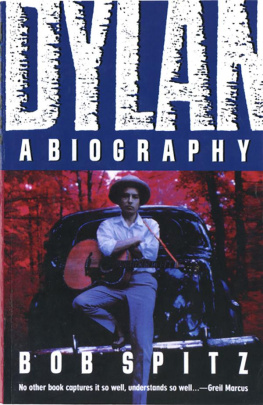Who Is
Bob Dylan?
Who Is
Bob Dylan?
By Jim OConnor
Illustrated by John OBrien

To Jane, who is everything to meJOC
For my favorite niece, HannahJOB
GROSSET & DUNLAP
Published by the Penguin Group
Penguin Group (USA) Inc., 375 Hudson Street, New York, New York 10014, USA
Penguin Group (Canada), 90 Eglinton Avenue East, Suite 700, Toronto, Ontario M4P 2Y3, Canada (a division of Pearson Penguin Canada Inc.)
Penguin Books Ltd, 80 Strand, London WC2R 0RL, England
Penguin Ireland, 25 St Stephens Green, Dublin 2, Ireland (a division of Penguin Books Ltd)
Penguin Group (Australia), 707 Collins Street, Melbourne, Victoria 3008, Australia
(a division of Pearson Australia Group Pty Ltd)
Penguin Books India Pvt Ltd, 11 Community Centre, Panchsheel Park, New Delhi110 017, India
Penguin Group (NZ), 67 Apollo Drive, Rosedale, Auckland 0632, New Zealand (a division of Pearson New Zealand Ltd)
Penguin Books (South Africa), Rosebank Office Park, 181 Jan Smuts Avenue, Parktown North 2193, South Africa
Penguin China, B7 Jiaming Center, 27 East Third Ring Road North, Chaoyang District, Beijing 100020, China
Penguin Books Ltd, Registered Offices: 80 Strand, London WC2R 0RL, England
All rights reserved. No part of this book may be reproduced, scanned, or distributed in any printed or electronic form without permission. Please do not participate in or encourage piracy of copyrighted materials in violation of the authors rights. Purchase only authorized editions.
Text copyright 2013 by Jim OConnor. Illustrations copyright 2013 by John OBrien. Cover illustration copyright 2013 by Nancy Harrison. Published by Grosset & Dunlap, a division of Penguin Young Readers Group, 345 Hudson Street, New York, New York 10014. GROSSET & DUNLAP is a trademark of Penguin Group (USA) Inc.
Library of Congress Cataloging-in-Publication Data is available.
ISBN: 978-0-698-15945-7


Who Is
Bob Dylan?

On Mothers Day, 1946, a four-year-old boy wanted to sing a special song to his grandmother. He had practiced it and now he was ready. But all the grown-ups in the room were laughing and talking. No one was paying attention to him.
Finally Bobby Zimmerman had had enough. He stamped his foot on the floor until all the grown-ups stopped talking.
If everybody in this room will keep quiet, I will sing for my grandmother. Im going to sing Some Sunday Morning. When he finished, the grown-ups clapped and cheered for the little boy. So Bobby decided to sing the only other song he knew. There was more applause and cheering from all his relatives. Bobby liked it.
Sixty-six years later, in 2012, President Barack Obama presented the Medal of Freedom to Bobby Zimmerman. By then, he was known as Bob Dylan. The Medal of Freedom is the highest award given to people who are not soldiers. The little boy had become one of the most famous singers and songwriters in the world.
There is not a bigger giant in the history of American music, the president said. He is still chasing that sound, still searching for a little bit of truth. And I have to say that I am a really big fan.
How did Robert Allan Zimmerman become Bob Dylan? Who is the real Bob Dylan? He is many things. A singer, a songwriter, an actor, an author, a filmmaker.
Bob Dylan is also one of the most private people in the world. Unlike many famous people, he wants to keep who he is a secret.

Chapter 1
Hibbing

Robert Allan Zimmerman was born in Duluth, Minnesota, on May 24, 1941. His parents were Abe Zimmerman and Beatrice Beatty Stone. In 1946 Bobs younger brother, David, was born. That same year Abe Zimmerman caught polio, a disease that left him with a limp.
Abe survived but was very sick for a long time. The Zimmermans decided to move to Hibbing, Minnesota. It was Beattys hometown. Her family could help out while Abe slowly recovered.
Hibbing was a small town in a part of northern Minnesota called the Iron Range. The mining of iron ore was the biggest industry. Abe ran a small furniture and appliance store there.
When Bob Zimmerman was growing up in Hibbing, there were only sixteen thousand people living there. Everyone knew everyone else. No one wanted to stand out or be different. On Sundays, most families went to church. The Zimmermans were among the few Jewish families. Bobby Zimmerman studied Hebrew and was bar mitzvahed when he was thirteen. That is a ceremony that celebrates a Jewish boy becoming a man.
But just three years later, Bob began to tell friends that he was not Jewish. He also began to make up stories about himself. He said he had run away from home many times. Not true. He said he had worked in a circus. Not true. Later he began to tell people that he was an orphan. Absolutely not true. Why did he make up these stories? Maybe he thought they made him seem more interesting. Maybe he had reasons for hiding his true identity.
At ten Bob decided to learn to play a musical instrument. His cousin gave him one piano lesson before Bob announced that he would teach himself. And he did!
But what kind of music would he play? In the early 1950s, few teenagers in Hibbing listened to a new kind of music called rock and roll. The local radio station in Hibbing was, like the town itself, conservative and dull. None of the music it played appealed to Bob. At night he could listen to radio stations from as far away as Louisiana. He loved the mix of gospel music, blues, and black rhythm and blues.





























